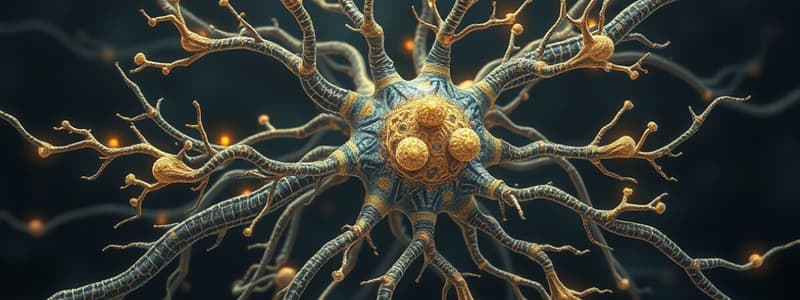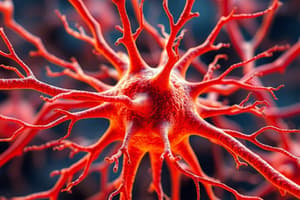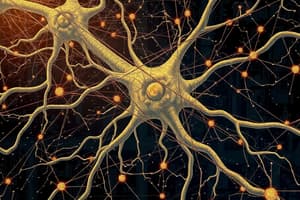Podcast
Questions and Answers
What is a Neuron?
What is a Neuron?
Neural cell; basic building block of the nervous system made up of specific structures: dendrites, cell body, axon, and terminal buttons.
What are Glial Cells?
What are Glial Cells?
Cells in the nervous system that support, nourish, and protect neurons.
What is the Cell Body (Soma)?
What is the Cell Body (Soma)?
Contains the nucleus and other parts of the cell needed to sustain its life.
What is an Axon?
What is an Axon?
What is the Myelin Sheath?
What is the Myelin Sheath?
What are Terminal Buttons?
What are Terminal Buttons?
What is a Synapse?
What is a Synapse?
What are Dendrites?
What are Dendrites?
What are Receptor Sites?
What are Receptor Sites?
What is Resting Potential?
What is Resting Potential?
What is Action Potential?
What is Action Potential?
What is Neural Firing?
What is Neural Firing?
What is the All-or-None Principle?
What is the All-or-None Principle?
What is a Threshold?
What is a Threshold?
What is the Refractory Period?
What is the Refractory Period?
What is Reuptake?
What is Reuptake?
What are Neurotransmitters?
What are Neurotransmitters?
What are Excitatory Neurotransmitters?
What are Excitatory Neurotransmitters?
What are Inhibitory Neurotransmitters?
What are Inhibitory Neurotransmitters?
What is Acetylcholine?
What is Acetylcholine?
What is Dopamine?
What is Dopamine?
What are Endorphins?
What are Endorphins?
What is Serotonin?
What is Serotonin?
What is Norepinephrine?
What is Norepinephrine?
What is GABA?
What is GABA?
What is Glutamate?
What is Glutamate?
What is an Agonist?
What is an Agonist?
What is an Antagonist?
What is an Antagonist?
Flashcards
Neuron
Neuron
Basic unit of the nervous system, receiving, processing, and transmitting information.
Dendrite
Dendrite
Branching extensions receiving signals from other neurons.
Cell Body (Soma)
Cell Body (Soma)
Part of the neuron containing the nucleus, maintaining its function.
Axon
Axon
Long fiber transmitting signals away from the cell body.
Signup and view all the flashcards
Terminal Buttons
Terminal Buttons
Endings of axons releasing neurotransmitters.
Signup and view all the flashcards
Myelin Sheath
Myelin Sheath
Fatty layer speeding up signal transmission.
Signup and view all the flashcards
Glial Cells
Glial Cells
Supporting cells nourishing and protecting neurons.
Signup and view all the flashcards
Synapse
Synapse
Gap between neurons where neurotransmitters are released.
Signup and view all the flashcards
Neurotransmitters
Neurotransmitters
Chemical messengers carrying signals between neurons.
Signup and view all the flashcards
Receptor Sites
Receptor Sites
Specialized areas receiving specific neurotransmitters.
Signup and view all the flashcards
Resting Potential
Resting Potential
Neuron's negative electrical charge when inactive.
Signup and view all the flashcards
Action Potential
Action Potential
Brief electrical charge traveling down the axon.
Signup and view all the flashcards
Neural Firing
Neural Firing
Electrochemical process of signal transmission.
Signup and view all the flashcards
All-or-None Principle
All-or-None Principle
Neuron either fires completely or not at all.
Signup and view all the flashcards
Refractory Period
Refractory Period
Time after firing when neuron cannot immediately fire again.
Signup and view all the flashcards
Reuptake
Reuptake
Neurotransmitter reabsorption by the presynaptic neuron.
Signup and view all the flashcards
Excitatory Neurotransmitters
Excitatory Neurotransmitters
Stimulate the next neuron to fire.
Signup and view all the flashcards
Inhibitory Neurotransmitters
Inhibitory Neurotransmitters
Prevent the next neuron from firing.
Signup and view all the flashcards
Acetylcholine
Acetylcholine
Neurotransmitter involved in memory, learning, and movement.
Signup and view all the flashcards
Dopamine
Dopamine
Neurotransmitter influencing mood, movement, and alertness.
Signup and view all the flashcards
Endorphins
Endorphins
Neurotransmitters acting as natural painkillers.
Signup and view all the flashcards
Serotonin
Serotonin
Neurotransmitter impacting mood, sleep, and appetite.
Signup and view all the flashcards
Norepinephrine
Norepinephrine
Influencing alertness, focus, and the stress response.
Signup and view all the flashcards
GABA
GABA
Major inhibitory neurotransmitter, calming the nervous system.
Signup and view all the flashcards
Glutamate
Glutamate
Major excitatory neurotransmitter, crucial for learning.
Signup and view all the flashcards
Agonists
Agonists
Molecules enhancing neurotransmitter effects.
Signup and view all the flashcards
Antagonists
Antagonists
Molecules blocking neurotransmitter actions.
Signup and view all the flashcardsStudy Notes
Neurons and Their Structure
- Neurons serve as the fundamental units of the nervous system, composed of dendrites, cell body (soma), axon, and terminal buttons.
- Dendrites are extensions that receive signals from other neurons, enabling synaptic connections.
- The cell body, containing the nucleus, sustains cell function.
- Axons are long, wirelike structures transmitting signals away from the cell body, ending in terminal buttons.
- Myelin sheath is a fatty layer around axons that accelerates neural signal transmission.
Supporting Cells
- Glial cells support, nourish, and protect neurons in the nervous system, playing vital roles in maintaining overall brain health.
Neurotransmission
- A synapse is the gap between terminal buttons of one neuron and dendrites of another, where neurotransmitters are released to facilitate communication.
- Receptor sites on dendrites are specialized for specific neurotransmitters, influencing neuronal firing.
Neural Processes
- Resting potential refers to the neuron's negatively charged state when inactive, while action potential is a brief electrical charge that propagates along the axon upon reaching the threshold.
- Neural firing is an electrochemical process involving electrical signals within neurons and chemical neurotransmitters between them.
Principles of Neural Activity
- The all-or-none principle states that a neuron either fully fires or does not fire at all when the threshold is met.
- After firing, neurons enter a refractory period where they cannot immediately fire again until they return to resting potential.
- Reuptake is the process where a neurotransmitter is reabsorbed by the original neuron after signal transmission.
Types of Neurotransmitters
- Neurotransmitters are chemical messengers that cross synaptic gaps, binding to receptor sites on the next neuron to influence neural impulses.
- Excitatory neurotransmitters stimulate the next neuron to fire, while inhibitory neurotransmitters prevent it from firing.
Specific Neurotransmitters and Their Functions
- Acetylcholine: Involved in motor movement, learning, and memory; its deficiency links to Alzheimer's disease.
- Dopamine: Regulates motor movement, alertness, and emotions; imbalances affect conditions like Parkinson's disease and schizophrenia.
- Endorphins: Act as natural painkillers and influence pleasure; connected to addiction mechanisms.
- Serotonin: Regulates mood, hunger, sleep, and arousal; low levels are associated with depression.
- Norepinephrine: Plays a role in alertness and arousal, affecting mood; part of the body's stress response.
- GABA: Major inhibitory neurotransmitter; deficiencies can lead to seizures and insomnia.
- Glutamate: Principal excitatory neurotransmitter; excess can lead to overstimulation, migraines, or seizures.
Drug Interactions with Neurotransmitters
- Agonists: Molecules that enhance or mimic the effect of neurotransmitters, promoting a physiological response.
- Antagonists: Molecules that inhibit or block neurotransmitter action, diminishing or preventing a physiological response.
Studying That Suits You
Use AI to generate personalized quizzes and flashcards to suit your learning preferences.




